Safe Pressure Washers for Home Use – Buy Smart
Pressure washers are powerful tools that can make home cleaning tasks faster and more effective. Whether you’re removing grime from your driveway, mold from your siding, or dirt from patio furniture, a pressure washer seems like the perfect solution. But here’s the catch: when used incorrectly or when the wrong machine is chosen, pressure washers can cause expensive, irreversible damage to your home.
From stripping paint off siding to etching patterns into concrete or destroying wood fibers, the risks are real. That’s why selecting a safe pressure washer for home use is more than just a convenience — it’s a necessity. In this guide, we’ll help you navigate the critical factors, from pressure ratings to safety features, and explore the best pressure washers of 2025 that prioritize both power and protection.
Understanding Pressure Ratings: What’s Safe for Each Surface
One of the most common mistakes homeowners make when pressure washing is using the wrong pressure rating for the task at hand. While it might seem like “the higher the PSI, the better,” the truth is, using too much pressure can permanently damage surfaces around your home — from gouging softwood to loosening mortar in brick walls.
To clean safely and effectively, you need to understand the balance between PSI (pounds per square inch) and GPM (gallons per minute). These two metrics work together: PSI determines the force of the water spray, while GPM controls how much water is used to rinse and carry debris away. A good pressure washer doesn’t just hit hard — it also rinses efficiently.
🔍 What Do PSI and GPM Really Mean?
- PSI (Pressure): This measures the pressure or force of the water stream. Higher PSI can remove tougher grime but may also damage delicate surfaces.
- GPM (Flow Rate): This is how much water flows from the washer per minute. A higher GPM means better rinsing and faster cleaning, especially on large surfaces.
👉 A good rule of thumb:
Use the lowest PSI that gets the job done. This helps preserve surface integrity and reduces the chance of unintentional damage.
✅ Safe Pressure Levels by Surface Type
Here’s a comprehensive guide to help you match the right pressure setting and nozzle type for various common household surfaces:
| Surface | Recommended PSI | Suggested Nozzle | Safety Tips |
|---|---|---|---|
| Softwood (decks, fences) | 500–1,200 PSI | 25°–40° (green or white) | Keep nozzle 12–18″ away, move in sweeping motion. Test a small area first. |
| Composite decking | 1,300–1,800 PSI | 40° (white) | Use lower pressure to avoid stripping protective coating. |
| Vinyl siding | 1,300–1,600 PSI | 25°–40° | Spray at a downward angle to prevent water intrusion behind panels. |
| Painted surfaces | 1,200–1,500 PSI | 40° (white) | High pressure can peel paint. Ideal for light cleaning, not paint removal. |
| Vehicles (cars, motorcycles) | 1,200–1,900 PSI | 40° (white) | Never use narrow nozzles. Avoid spraying directly into wheel wells or engine bay. |
| Concrete (driveways, sidewalks) | 2,500–3,000 PSI | 15°–25° (yellow or green) | Start with wider angle and adjust as needed. Don’t linger in one spot. |
| Brick and masonry | 1,500–2,500 PSI | 25° (green) | Keep a safe distance to avoid damaging mortar joints. |
| Windows and glass | Not recommended | 40° (white, very gentle) | Prefer garden hose with spray attachment. Use extreme caution. |
| Outdoor furniture (plastic, metal) | 1,300–2,000 PSI | 25°–40° | Clean with detergent first, then rinse with moderate pressure. |
🎯 How to Adjust Pressure Safely
Most modern pressure washers, especially electric models, offer adjustable pressure settings or come with interchangeable nozzles to vary the spray intensity. Some higher-end units even feature smart pressure sensors or digital controls to fine-tune pressure levels with precision.
Here are a few pressure-adjustment strategies:
Start Low, Go Higher: Always begin with a low PSI and a wide-angle nozzle (like 40°). Increase only if the dirt isn’t coming off.
Use Nozzles Smartly: Wider angles reduce the intensity of the spray, making them ideal for delicate surfaces. Narrow nozzles concentrate the spray and can easily cause damage.
Distance Matters: The closer the nozzle is to the surface, the higher the pressure. Maintain at least 12 inches of distance when starting out.
⚠️ Dangers of Using Too Much Pressure
Using excessive PSI can be worse than using too little. Here’s what can go wrong:
Wood damage: Can splinter or “fuzz” the surface, causing permanent texture change.
Paint stripping: While great if you want to remove paint, it can be a disaster if you’re trying to preserve the finish.
Mortar erosion: High PSI can loosen bricks or degrade the mortar holding them together.
Water intrusion: Spraying upward into siding or cracks can force water behind walls, leading to mold and rot.
Personal injury: Direct hits to skin with high PSI can cause serious injuries — even lacerations.
🧼 Matching Detergents to Surfaces
Using the right cleaning solution enhances cleaning power without relying on high pressure. Most surfaces will benefit from a pre-soak with detergent:
Wood decks: Use a wood-safe, oxygenated cleaner.
Siding: Mold and mildew removers with surfactants work best.
Vehicles: Use pH-balanced, vehicle-safe soap.
Pro tip: Always rinse thoroughly after using detergent. Some residues can damage paint or attract more dirt.
🔄 GPM Matters Too: Why Flow Rate Shouldn’t Be Ignored
While PSI grabs the headlines, GPM is often the silent workhorse in efficient cleaning. A machine with slightly lower PSI but higher GPM will rinse faster and more effectively.
For example:
A 1,500 PSI washer with 2.0 GPM may outperform a 2,000 PSI washer with only 1.2 GPM for cleaning large flat surfaces.
When shopping for pressure washers, look for balanced ratings — for home use, a PSI of 1,800–2,300 combined with 1.5–2.3 GPM is usually ideal.
🔧 Understanding Pressure Washer Ratings (CU)
Cleaning Units (CU) = PSI × GPM
This gives a quick snapshot of a washer’s overall cleaning ability.
| PSI | GPM | CU | Cleaning Power |
|---|---|---|---|
| 1,800 | 1.2 | 2,160 | Light duty |
| 2,000 | 1.4 | 2,800 | Medium duty |
| 3,000 | 2.5 | 7,500 | Heavy duty |
Don’t just chase high CU numbers — consider what you’re cleaning, and choose based on surface safety, not raw power.
✅ Quick Tips for First-Time Buyers
Know your surfaces: Make a list of areas you plan to clean and match their recommended PSI.
Stick with adjustable or variable-pressure washers: More flexibility equals more safety.
Invest in nozzle kits: The right spray angle can make all the difference.
Test first: Try cleaning a small, hidden area before going all-in on a surface.
With this deeper understanding of pressure ratings and how they apply to real-world cleaning scenarios, you’ll be empowered to select the right washer and use it confidently — without worrying about damaging your property. In the next sections, we’ll dive into model comparisons and technique tips to further guide you toward safe and smart pressure washing in 2025.
Electric vs. Gas Pressure Washers: Pros & Cons
When buying a pressure washer for home use, one of the first and most important decisions you’ll face is choosing between an electric or a gas-powered model. While both types can get the job done, they’re designed for different cleaning needs, environments, and user preferences.
Understanding the true differences in power, convenience, cost, and long-term maintenance will help you make a smart, safe choice — one that not only matches your cleaning tasks but also prevents unnecessary wear, damage, or frustration.
Let’s break down the key differences.
⚡ Electric Pressure Washers: The Homeowner’s Best Friend
Electric pressure washers are the go-to choice for the majority of residential users — and for good reason. They offer a great balance of cleaning power and safety, with less hassle.
✅ Pros of Electric Pressure Washers
User-Friendly & Lightweight
Most models are compact, portable, and light enough to carry or wheel around the yard with ease.Quiet Operation
Significantly quieter than gas models — ideal for neighborhoods with noise restrictions or close neighbors.Low Maintenance
No oil changes, spark plugs, or air filters. Just plug and spray.Safe for Delicate Surfaces
With pressure typically ranging between 1,300–2,300 PSI, electric washers are less likely to damage wood, paint, or siding.Eco-Friendly
No fuel or emissions. Great for indoor garages, patios, and other semi-enclosed spaces.Budget-Friendly
Starting as low as €100–€150, electric models are generally more affordable than gas alternatives.
⚠️ Cons of Electric Pressure Washers
Lower Power Ceiling
Most models cap out at around 2,300 PSI — fine for cars, decks, and siding, but not powerful enough for stripping paint or cleaning heavily soiled concrete.Limited by Cord Length
You’ll need access to a power outlet. Even with an extension cord, range can be a challenge for large properties.Shorter Hose Lengths
Typically come with shorter, thinner hoses than gas models, which may affect comfort and reach.Durability
Consumer-grade electric washers aren’t built for daily use or high-frequency commercial jobs.
⛽ Gas Pressure Washers: Power for the Tough Jobs
Gas-powered pressure washers are built for serious cleaning power and extended use. They’re widely used by professionals, but they can be great for homeowners who need raw force for heavy-duty tasks.
✅ Pros of Gas Pressure Washers
High PSI and GPM Ratings
Models range from 2,500 to over 4,000 PSI, with GPM rates between 2.3 and 4.0+, allowing for deep cleaning and faster results.No Electricity Needed
Ideal for rural areas, farms, or large outdoor spaces without nearby power outlets.Longer Hoses & Accessories
Typically come with more rugged components: longer high-pressure hoses, reinforced wheels, and stronger spray guns.Versatile for All Surfaces
With adjustable nozzles or pressure regulators, gas models can handle anything from brick to metal to oil-stained driveways.Ideal for Frequent Use
Designed for frequent, prolonged use. Built to last if properly maintained.
⚠️ Cons of Gas Pressure Washers
Noisier Operation
Much louder than electric models — ear protection is often recommended.Heavier and Bulkier
With weight often exceeding 60–100 lbs, they’re not ideal for smaller homeowners or those with limited storage.Regular Maintenance Required
Like lawnmowers, they need oil changes, spark plug inspections, and seasonal prep.Fumes and Emissions
Can’t be used in enclosed spaces due to exhaust — not safe for indoor garages or basements.Greater Risk of Damage
High PSI can easily etch concrete, tear paint, or damage siding if used carelessly.
⚖️ Side-by-Side Comparison: Electric vs. Gas Pressure Washers
| Feature | Electric Pressure Washer | Gas Pressure Washer |
|---|---|---|
| PSI Range | 1,300 – 2,300 | 2,500 – 4,000+ |
| GPM Range | 1.2 – 2.0 | 2.3 – 4.0 |
| Best Use Cases | Cars, siding, decks, patios | Driveways, paint removal, stonework |
| Noise Level | Low | High |
| Weight | 15 – 35 lbs | 60 – 100+ lbs |
| Ease of Use | Plug-and-play | Requires fuel and engine start |
| Maintenance Needs | Minimal | Moderate to high |
| Eco-Friendliness | No emissions | Emits carbon monoxide |
| Price Range | €100 – €300 | €300 – €800+ |
| Storage Requirements | Compact | Bulky |
If you’re unsure which way to go, consider premium electric models with brushless motors, such as the Greenworks Pro 2300 PSI or Ryobi RY142300. These units deliver nearly gas-like performance with the safety and simplicity of electric operation.
Alternatively, if you’re leaning toward gas but worried about overkill, look for consumer-grade gas models in the 2,500–2,700 PSI range with adjustable pressure settings — offering a middle ground between brute force and surface safety.
Best Pressure Washers for Safe Home Cleaning
Choosing the right pressure washer for your home goes beyond just power ratings. The best models combine ease of use, versatility, and built-in safety features to ensure effective cleaning without the risk of damaging surfaces. Below are some of the most reliable and homeowner-friendly pressure washers available in 2025, ideal for a variety of outdoor cleaning tasks.
Sun Joe SPX3000-XT1 XTREAM Electric Pressure Washer
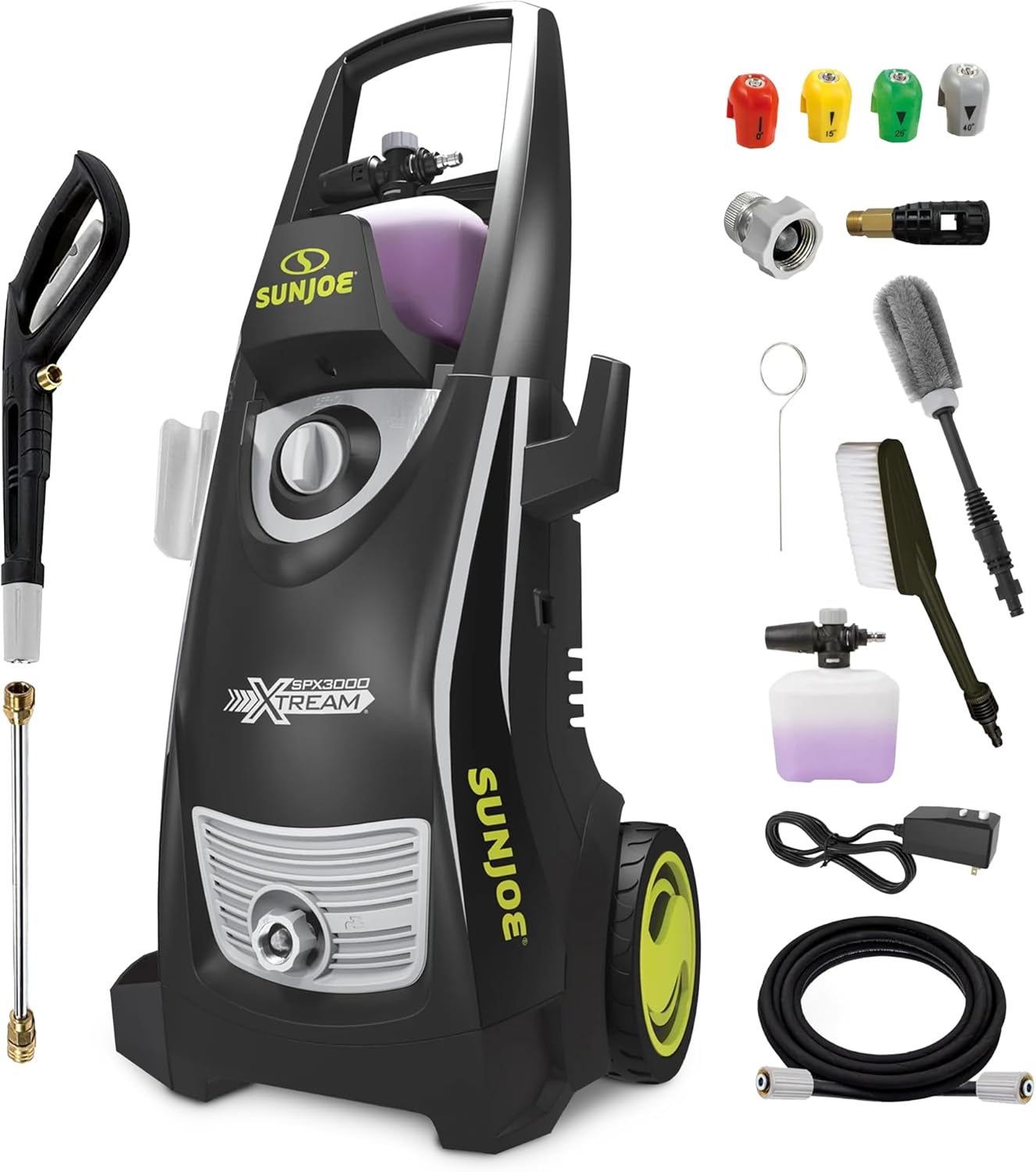
Max PSI: 2,200
GPM: 1.65
Motor: 13-amp brush motor
Included Nozzles: 0°, 15°, 25°, 40°, soap
Detergent Tanks: Dual 0.9L tanks
The Sun Joe SPX3000-XT1 is designed for safe and efficient residential use. With a moderate pressure output, it’s well-suited for cleaning patios, decks, siding, and vehicles without the risk of surface damage. The unit comes with multiple quick-connect nozzles, allowing users to adjust spray angles based on surface sensitivity.
Its dual detergent tanks let you switch between cleaning solutions for different tasks, like one tank for car soap and another for siding cleaner. The Total Stop System (TSS) automatically shuts off the pump when the trigger isn’t engaged, reducing wear and increasing lifespan. With a wide-angle nozzle and proper distance, users can safely wash wooden surfaces or delicate paintwork without causing erosion or streaking.
Greenworks Pro 2300 Max PSI Brushless Electric Pressure Washer
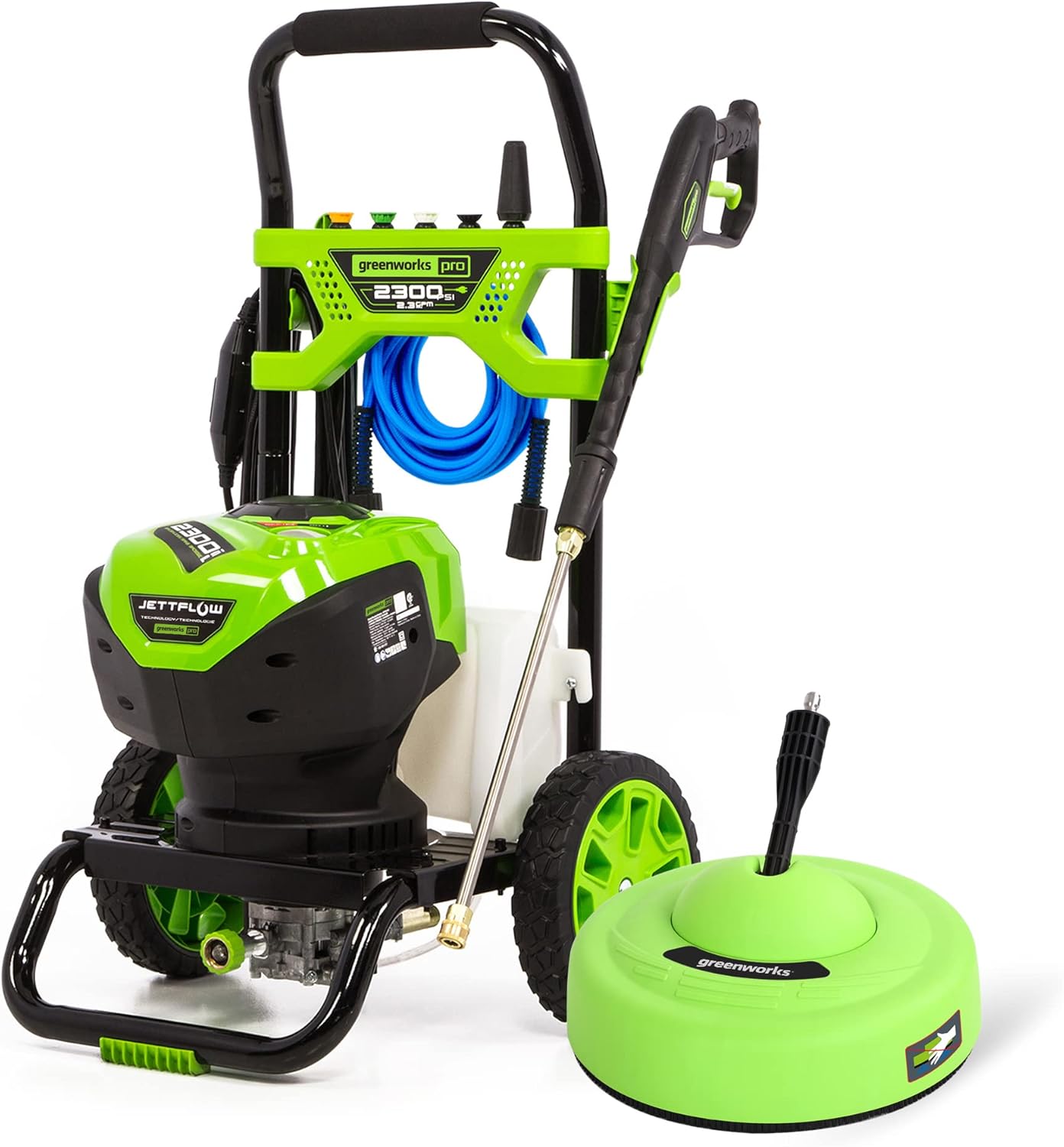
Max PSI: 2,300
GPM: 2.3
Motor: Brushless induction motor
Included Nozzles: 15°, 25°, 40°, turbo, soap
Hose Length: 25 ft kink-resistant hose
Certification: PWMA certified
This model offers one of the best balances of cleaning power and safety for home users. With 2.3 GPM flow rate and a smart sensing system that adjusts pressure output based on nozzle use, it can tackle larger areas faster while avoiding overpressure on fragile surfaces. The included turbo nozzle is helpful for stubborn dirt on concrete, while the wide-angle nozzles are appropriate for vinyl siding and wood.
Its brushless motor ensures quieter operation and longer service life, making it suitable for extended weekend cleaning without disturbing neighbors. The sturdy frame and upright design make it easy to store, and the on-board hose reel adds convenience. For homeowners with a mix of surfaces — from driveways to garden furniture — this washer provides both versatility and reliability.
Ryobi RY142300 2300 PSI Brushless Electric Pressure Washer
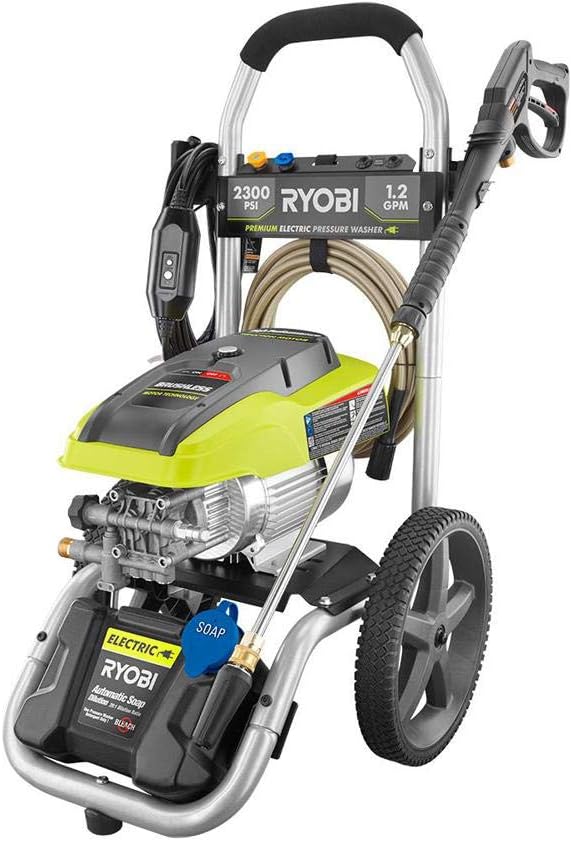
Max PSI: 2,300
GPM: 1.2
Motor: Brushless induction
Included Nozzles: 15°, 25°, soap
Frame: Heavy-duty roll-cage design
Warranty: 3 years
The Ryobi RY142300 is built with a solid steel frame that offers stability and protection, even on uneven outdoor terrain. While the GPM is slightly lower than others in its class, the machine compensates with steady, consistent pressure — especially useful for cleaning vertical surfaces like walls and fences.
This model is ideal for homeowners seeking a maintenance-free electric washer for seasonal use. Its low-noise operation and user-friendly interface make it accessible even to those with no prior experience. The included spray wand and nozzles are designed for controlled flow, allowing effective cleaning of car exteriors, painted shutters, or patio tiles without risk of stripping finishes or splintering surfaces.
Its soap applicator works best with pressure washer-specific detergents, and the pressure remains gentle enough to avoid damaging paint or siding when used with the 25° or 40° nozzles.
Simpson MegaShot MSH3125 Gas Pressure Washer
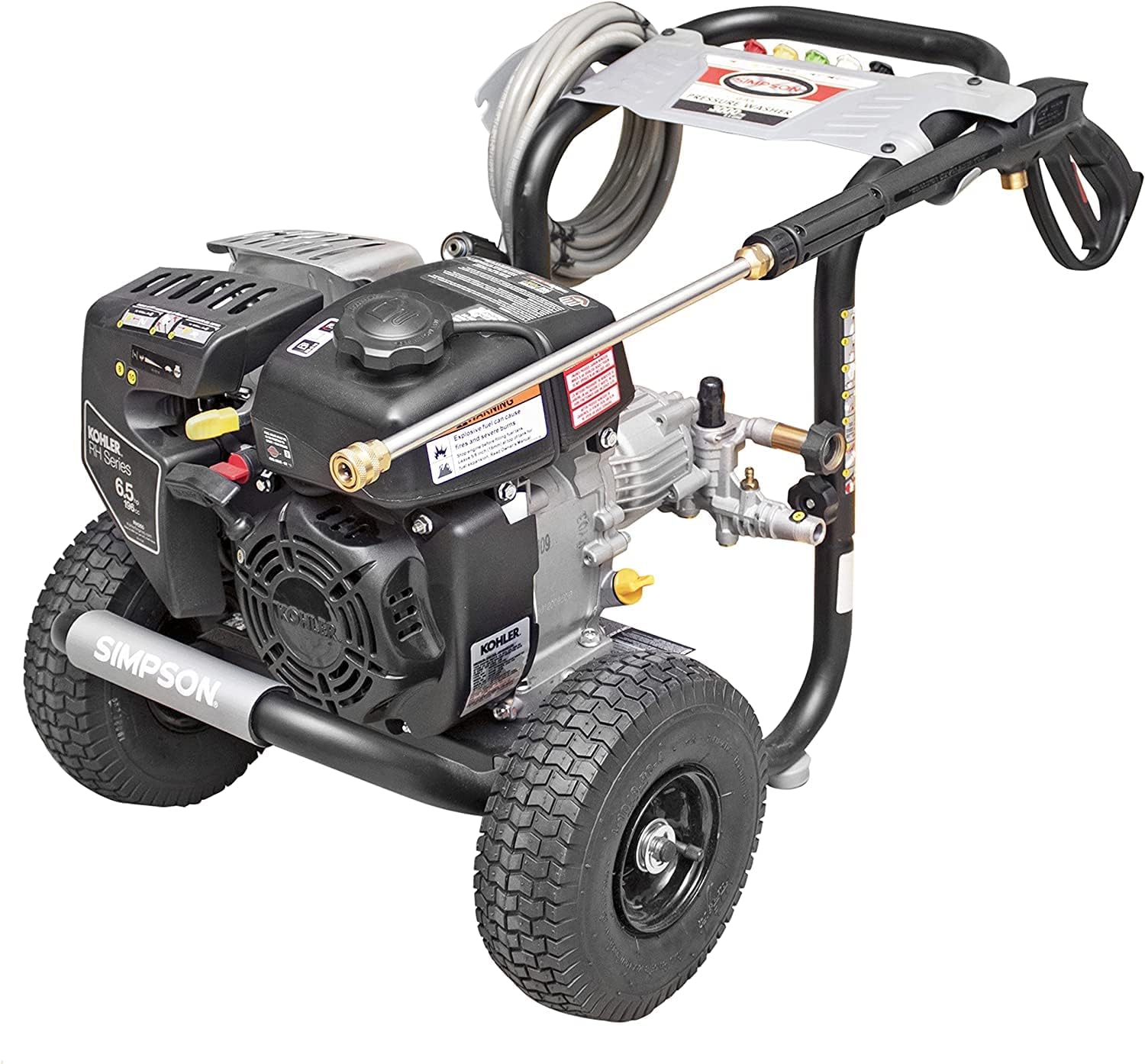
Max PSI: 3,200
GPM: 2.5
Engine: Honda GC190
Included Nozzles: 0°, 15°, 25°, 40°, soap
Frame: Welded steel with 10″ pneumatic tires
Pump: OEM Technologies axial cam pump
This gas-powered unit is suitable for users with prior pressure washing experience who need more power for heavy-duty cleaning. The Honda GC190 engine is highly regarded for its reliability and performance. The higher PSI and GPM allow faster removal of embedded grime on concrete driveways, stone walkways, and brick surfaces.
Because of its intensity, careful nozzle selection and distance management are essential to avoid unintended damage. The 40° nozzle is better for more delicate surfaces, while the 15° nozzle should be used cautiously on tougher materials. It’s important to never use the 0° nozzle on home siding or painted surfaces due to the risk of etching or peeling.
This model excels in performance but is best reserved for users who understand how to regulate distance and select proper spray tips for each surface. It’s ideal for large properties, farm equipment, or prepping surfaces for repainting.
AR Blue Clean AR630-HOT Industrial Electric Washer (For Advanced Users)
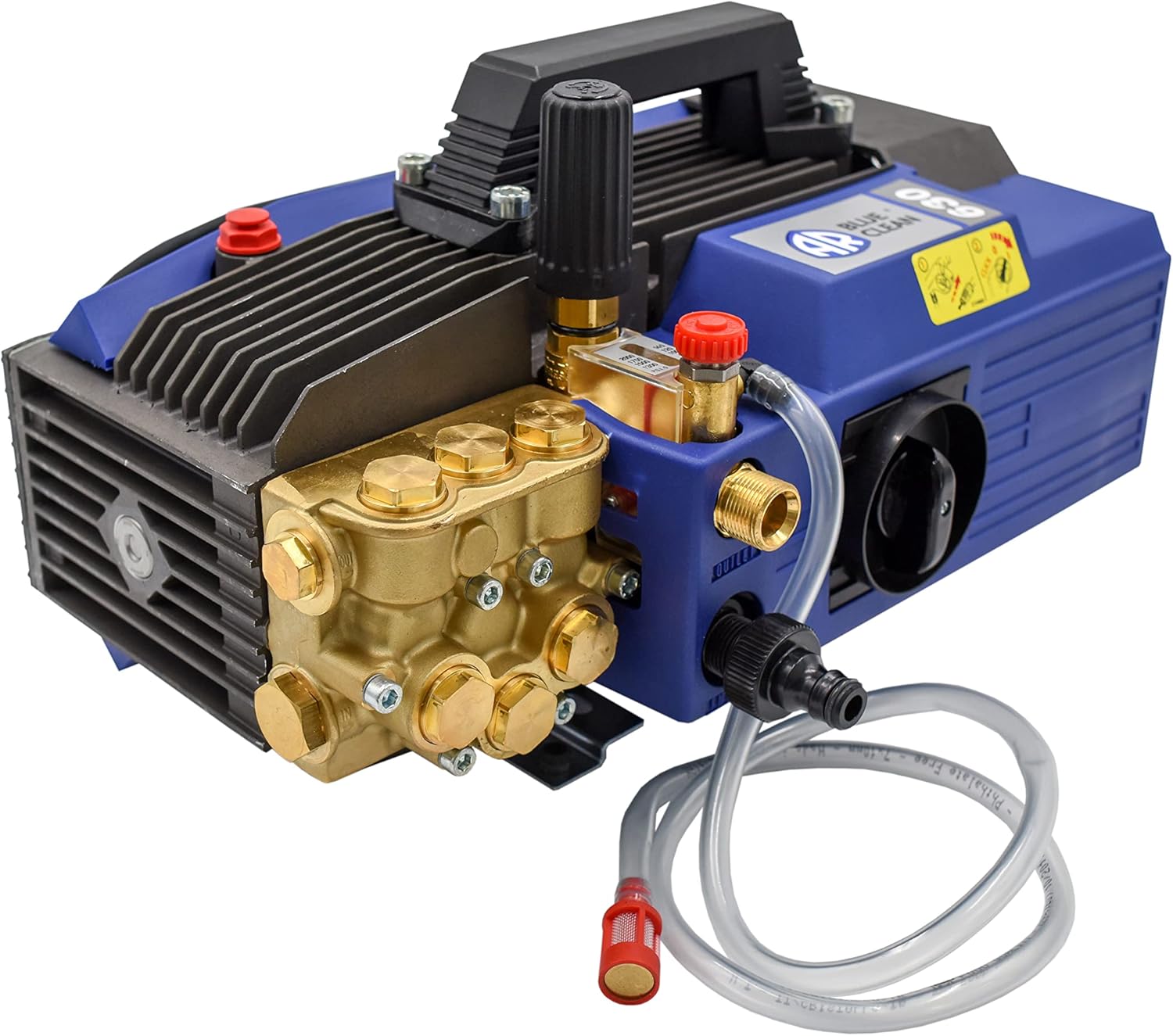
Max PSI: 1,900
GPM: 2.1
Motor: 2.0 HP, 120V
Temperature Rating: Accepts hot water up to 180°F
Use Case: Indoor/outdoor, industrial cleaning
Though this model is on the higher end in terms of cost and build, it offers unique capabilities for homeowners with specialized cleaning needs. The AR630-HOT supports high-temperature water input, which can help break down greasy residues or clean surfaces like grills, engines, or tile patios more efficiently.
It is a professional-grade unit with pressure suitable for home use, and it offers brass fittings and a durable triplex plunger pump for enhanced longevity. The industrial frame may be overbuilt for casual users, but it offers peace of mind for anyone looking for a long-lasting, premium electric washer with safe PSI levels.
Due to its power and design, it works well for workshops or garage settings where regular, deep cleaning is needed without the fumes or noise of a gas model.
Kärcher K5 Premium Smart Control Home
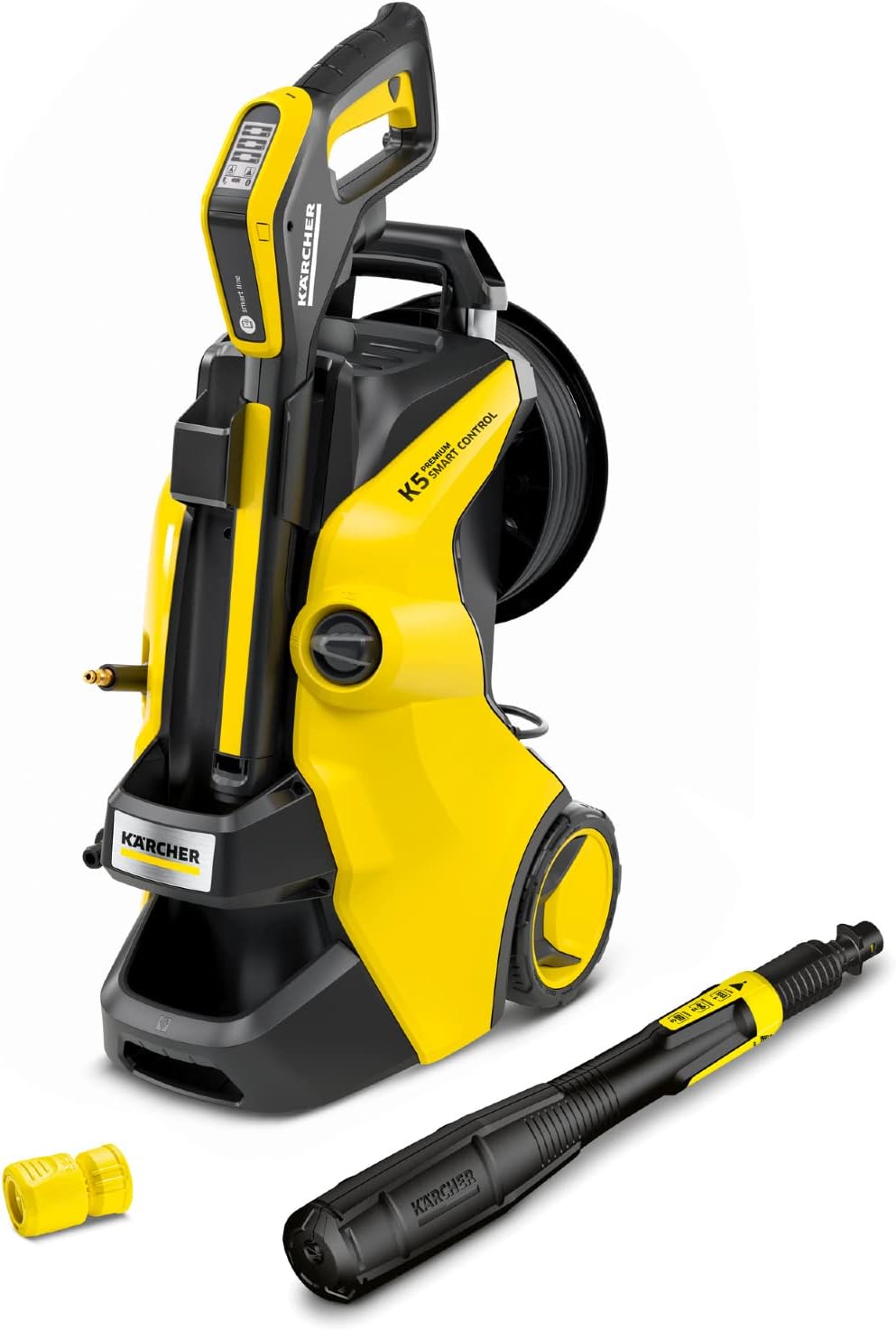
Max PSI: 2,000
GPM: 1.4
Smart Features: App connectivity, pressure control dial
Extras: Onboard hose reel, detergent tank, LCD trigger gun
This model is optimized for residential users who want convenience, safety, and precision. The smart trigger gun with LCD display lets you adjust pressure in real-time for different surfaces — from wood to concrete — with visual feedback. It’s especially helpful for users unsure about how much force is appropriate.
Kärcher’s Home Kit includes a surface cleaner attachment for patios and decking, reducing splash-back and improving consistency. It’s also one of the more stylish and ergonomic models on the market, with integrated storage for accessories and a telescoping handle.
While it doesn’t have the raw force of a gas washer, its pressure range is enough for cars, paving slabs, outdoor toys, and fencing, and the smart interface significantly lowers the learning curve.
Summary Table: Top Safe Pressure Washers for Home Use
| Model | Type | Max PSI | GPM | Ideal For |
|---|---|---|---|---|
| Sun Joe SPX3000-XT1 | Electric | 2,200 | 1.65 | General home use, decks, vehicles |
| Greenworks Pro 2300 | Electric | 2,300 | 2.3 | Siding, concrete, multi-surface |
| Ryobi RY142300 | Electric | 2,300 | 1.2 | Siding, furniture, seasonal use |
| Simpson MSH3125 | Gas | 3,200 | 2.5 | Concrete, heavy-duty tasks |
| AR Blue Clean AR630-HOT | Electric | 1,900 | 2.1 | Greasy areas, hot water jobs |
| Kärcher K5 Smart Control | Electric | 2,000 | 1.4 | Smart cleaning, patios, cars |
These pressure washers represent the best balance between performance and property safety. Whether you’re a homeowner cleaning once a month or a DIY enthusiast maintaining large outdoor spaces, choosing the right washer with the appropriate power level and safety features ensures long-term satisfaction — and keeps your property damage-free.
Proper Techniques to Avoid Damage
Even the safest pressure washer can cause damage if it’s used incorrectly. From splintered wood to etched concrete and stripped paint, misuse can turn a weekend cleaning project into a costly repair job. Knowing how to handle your washer, when to apply pressure, and which techniques to use for specific surfaces is just as important as choosing the right machine.
This section will walk you through correct handling techniques, nozzle usage, safety precautions, and cleaning strategies to help you clean efficiently — without risking your home, garden, or health.
🧼 1. Always Start With a Pre-Inspection
Before pulling the trigger, inspect the area you’re planning to clean. Look for:
Cracks or damaged surfaces: High-pressure water can worsen them.
Loose siding or shingles: Water can get underneath and cause leaks or mold.
Painted surfaces: Test a small patch to see how it reacts to water pressure.
Nearby plants or electronics: Cover delicate plants and electrical outlets with plastic sheeting or waterproof bags.
🎯 2. Choose the Right Nozzle for the Job
Using the correct spray tip is critical. Pressure washer nozzles are color-coded based on the spray angle and intensity:
| Color | Spray Angle | Usage | Warning |
|---|---|---|---|
| Red | 0° | Very tough stains (concrete, metal) | Can cut through wood, damage siding, or injure skin. Not recommended for most home use. |
| Yellow | 15° | Stripping paint, hard surfaces | Use only on durable surfaces like concrete. |
| Green | 25° | General cleaning – decks, siding | Good balance of power and coverage. |
| White | 40° | Vehicles, windows, softwood | Safest option for delicate tasks. |
| Black | 65° (Soap) | Applying detergent | Low-pressure for soaking, not rinsing. |
Start every job with a white or green nozzle, and adjust only if the results are insufficient. The narrower the angle, the higher the risk.
📏 3. Control Your Distance
The closer you are to the surface, the more concentrated the pressure. For safety and surface preservation:
Begin at least 18–24 inches away.
Gradually move closer if needed, but never closer than 6–8 inches unless using a wide-angle tip and low PSI.
For delicate materials like paint or vinyl, maintain a minimum distance of 12–18 inches.
Use a sweeping motion rather than holding the spray in one spot. Linger too long, and you risk cutting into wood, etching concrete, or removing paint unintentionally.
🔄 4. Use Smooth, Consistent Motions
Apply the water in even, horizontal or vertical strokes, overlapping each pass by about 30% to avoid streaking.
Move at a steady pace, similar to painting with a roller.
Don’t rush, but don’t pause in one spot either.
Work from the top down when cleaning walls or siding — this allows dirt and soap to flow downward naturally, preventing streaks.
On horizontal surfaces like decks or patios, go in one direction for a uniform clean. Alternating directions can result in visible lines or patchy results.
🧽 5. Pre-Treat Surfaces with Detergent
Soap or detergent is not just a time-saver — it protects surfaces by reducing the need for high pressure. Most pressure washers come with a dedicated detergent tank or a siphon hose for external bottles.
How to apply detergent safely:
Use only pressure-washer-safe cleaners.
Apply using the black (soap) nozzle to coat the surface evenly.
Let the solution sit for 5–10 minutes, but don’t let it dry.
Switch to a higher-pressure nozzle to rinse, starting from the bottom and moving up for siding, or top-down for concrete.
This method loosens grime chemically first, reducing the mechanical force (PSI) needed.
🚫 6. Avoid Direct Spraying Into Openings or Cracks
Never point the pressure washer nozzle:
Upward under siding – It can force water behind panels, leading to mold or insulation damage.
At windows – Especially older panes or wooden frames; glass can crack or seals may break.
Into vents, eaves, or soffits – These aren’t designed for high-pressure water and may leak.
When cleaning these areas, step back, use the widest spray angle, and reduce the pressure to the lowest setting.
⚠️ 7. Be Mindful of Electrical Hazards
Electric pressure washers are safe when used properly, but accidents can happen:
Keep all extension cords dry and rated for outdoor use.
Use GFCI outlets (ground fault circuit interrupter) for added protection.
Avoid spraying electrical panels, outlets, or appliances, even if they’re outdoors.
If using a gas washer, make sure to never operate indoors or in enclosed areas — carbon monoxide buildup can be fatal.
👷♂️ 8. Prioritize Personal Safety
Pressure washers can cause serious injury if mishandled. Safety precautions include:
Wear eye protection and gloves to prevent contact with debris or high-pressure spray.
Sturdy footwear with good grip is essential — wet surfaces become slippery.
Never point the wand at yourself, pets, or others — even low-pressure nozzles can cause injury.
Keep the spray gun’s safety lock on when not in use, especially around children.
If you’re using a ladder, do not operate the pressure washer while standing on it. The recoil can destabilize your balance. Instead, use a wand extension or pressure washer-safe scaffolding.
🛠️ 9. Use the Right Accessories for Safer Cleaning
Modern pressure washers come with a variety of attachments that can increase both efficiency and safety:
Surface cleaners: Ideal for driveways and decks. They distribute water evenly and prevent gouging.
Rotating brushes: Help with cleaning vehicles or textured surfaces without needing high PSI.
Telescoping wands: Reach second-story walls or gutters without needing a ladder.
Foam cannons: Apply thick layers of soap for pre-washing cars or siding gently.
These tools help distribute pressure more evenly and reduce the chance of over-cleaning one area.
🌿 10. Protect Plants, Pets, and Property
Pressure washing doesn’t only affect the surfaces you’re cleaning. Take a few steps to minimize unintentional harm:
Cover nearby plants with plastic or water them before and after cleaning to dilute any overspray from detergents.
Keep pets indoors during use. The noise and water pressure can scare or harm them.
Move outdoor furniture, décor, and light fixtures out of the spray zone to avoid damage.
Conclusion: Safe and Effective Cleaning Starts with Smart Choices
Pressure washing is one of the most efficient ways to maintain your home’s exterior, restore curb appeal, and eliminate stubborn dirt, mold, and grime. But power without control can quickly lead to damaged siding, splintered decks, or costly repairs — especially when the wrong equipment or technique is used.
By understanding pressure ratings, choosing the right electric or gas pressure washer for your specific needs, and learning the proper cleaning techniques, you can confidently take on everything from driveway stains to delicate paintwork without worry. The key isn’t just buying a powerful machine — it’s selecting one that’s safe, adjustable, and well-suited to your home’s surfaces.
Whether you opt for a lightweight electric model for casual use or a more robust gas unit for larger jobs, the pressure washers featured in this guide strike the right balance between performance and protection. Combined with the safety tips and nozzle recommendations shared here, you now have the knowledge to clean smarter, not harder.
